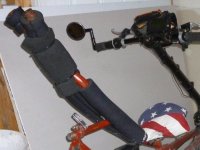llile
1 kW
- Joined
- Dec 18, 2010
- Messages
- 457
What have people done for Recumbent seats? Any aftermarket seats that have worked well for homebuilt frames? I've had more trouble with seats than any other part of a shop-made recumbent frame.
The problem is, there is a certain part of the butt that is made for sitting - right at the sitz-bones. That part of the pelvis is made to take your weight. If you have weight just a little forward of that point, your legs go numb from pressure on some nerve or blood vessel or something. Has anyone else struggled with this problem in recumbent seats? What did you do?
I've attached a detail of my current seat. It has been surprisingly successful, given that it isn't very conventional as recumbents go. It starts with a big cushy standard seat, turned around backwards so the horn is facing rear. The Sitz bones go on the cushy pad that is normally at the back of such a seat. i ground out the shape so my tailbone isn't sitting on anything, but my pelvis is, then covered it with a waterproof cover, that also happens to be an American flag pattern from an old camping chair. You can either think that I am very patriotic, or that I am sitting on the flag in complete disrespect, and that interpretation is up to you, I am going to be mum on the issue of politics.
The back is supported by two tubes, covered with closed cell foam from a gym equipment manufacturer. This is surprisingly comfortable, given that it is very firm. It also supports the back surprisingly well, as it sort of locks around the backbone.
The whole assembly is adjustable front and back, so taller or shorter riders could potentially use the bike. There is a bike downtube repurposed into a rear clamp, and a seat-tube running horizontally at the back of the seat, allowing front-to-back adjustment. At the bottom there is a rail with a 1/4" bolt that allows the seat to slide. Although adjustable, the assembly is quite rigid, allowing lots of force to be applied to the seat in hill climbing. So far I have never used this feature, leaving the seat in one place once I had it adjusted.
I have had zero luck with making mesh seats, and once tried to make a seat with lawn chair webbing, with equally poor results. A bike takes more force than a lawn chair (depending on how many twinkies one has eaten, I suppose) and the webbing swiftly failed. I haven't made much effort to look for an aftermarket seat, although I have had some luck buying 'bent replacement parts and using them on a shop-made frame.

The problem is, there is a certain part of the butt that is made for sitting - right at the sitz-bones. That part of the pelvis is made to take your weight. If you have weight just a little forward of that point, your legs go numb from pressure on some nerve or blood vessel or something. Has anyone else struggled with this problem in recumbent seats? What did you do?
I've attached a detail of my current seat. It has been surprisingly successful, given that it isn't very conventional as recumbents go. It starts with a big cushy standard seat, turned around backwards so the horn is facing rear. The Sitz bones go on the cushy pad that is normally at the back of such a seat. i ground out the shape so my tailbone isn't sitting on anything, but my pelvis is, then covered it with a waterproof cover, that also happens to be an American flag pattern from an old camping chair. You can either think that I am very patriotic, or that I am sitting on the flag in complete disrespect, and that interpretation is up to you, I am going to be mum on the issue of politics.
The back is supported by two tubes, covered with closed cell foam from a gym equipment manufacturer. This is surprisingly comfortable, given that it is very firm. It also supports the back surprisingly well, as it sort of locks around the backbone.
The whole assembly is adjustable front and back, so taller or shorter riders could potentially use the bike. There is a bike downtube repurposed into a rear clamp, and a seat-tube running horizontally at the back of the seat, allowing front-to-back adjustment. At the bottom there is a rail with a 1/4" bolt that allows the seat to slide. Although adjustable, the assembly is quite rigid, allowing lots of force to be applied to the seat in hill climbing. So far I have never used this feature, leaving the seat in one place once I had it adjusted.
I have had zero luck with making mesh seats, and once tried to make a seat with lawn chair webbing, with equally poor results. A bike takes more force than a lawn chair (depending on how many twinkies one has eaten, I suppose) and the webbing swiftly failed. I haven't made much effort to look for an aftermarket seat, although I have had some luck buying 'bent replacement parts and using them on a shop-made frame.




